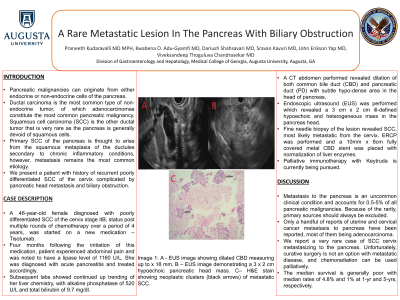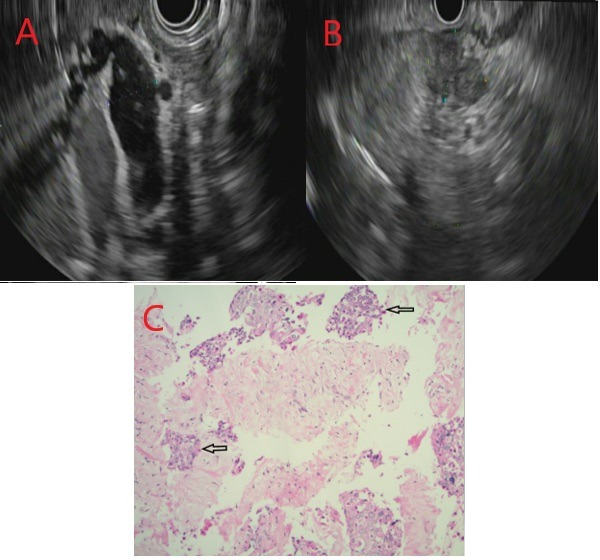Back


Poster Session A - Sunday Afternoon
Category: Biliary/Pancreas
A0032 - A Rare Metastatic Lesion in the Pancreas Presenting With Biliary Obstruction
Sunday, October 23, 2022
5:00 PM – 7:00 PM ET
Location: Crown Ballroom

Has Audio

Praneeth Kudaravalli, MD
Augusta University Medical Center
Augusta, GA
Presenting Author(s)
Praneeth Kudaravalli, MD1, Kwabena O. Adu-Gyamfi, MBChB2, Dariush Shahsavari, MD2, Sravan Kavuri, MD3, John Erikson L. Yap, MD4, Viveksandeep Chandrasekar, MBBS4
1Augusta University Medical Center, Augusta, GA; 2Medical College of Georgia - Augusta University, Augusta, GA; 3Augusta University, Augusta, GA; 4Augusta University Medical College of Georiga, Augusta, GA
Introduction: Pancreatic malignancies can originate from either endocrine or non-endocrine cells of the pancreas. Ductal carcinoma is the most common type of non-endocrine tumor, of which adenocarcinomas constitute the most common pancreatic malignancy. Squamous cell carcinoma (SCC) is the other ductal tumor that is very rare as the pancreas is generally devoid of squamous cells. Primary SCC of the pancreas is thought to arise from the squamous metaplasia of the ductules secondary to chronic inflammatory conditions, however, metastasis remains the most common etiology. We present a patient with history of recurrent poorly differentiated SCC of the cervix complicated by pancreatic head metastasis and biliary obstruction.
Case Description/Methods: A 46-year-old female diagnosed with poorly differentiated SCC of the cervix stage IIB, status post multiple rounds of chemotherapy over a period of 4 years, was started on a new medication – Tisotumab. Four months following the initiation of this medication, patient experienced abdominal pain and was noted to have a lipase level of 1160 U/L. She was diagnosed with acute pancreatitis and treated accordingly. Subsequent labs showed continued up trending of her liver chemistry, withalkaline phosphatase of 520 U/L and total bilirubin of 9.7 mg/dl. A CT abdomen performed revealed dilation of both common bile duct (CBD) and pancreatic duct (PD) with subtle hypodense area in the head of pancreas. Endoscopic ultrasound (EUS) was performed which revealed a 3 cm x 2 cm ill-defined hypoechoic and heterogenous mass in the pancreas head. Fine needle biopsy of the lesion revealed SCC, most likely metastatic from the cervix. ERCP was performed and a 10mm x 8cm fully covered metal CBD stent was placed with normalization of liver enzymes. Palliative immunotherapy with Keytruda is currently being pursued.
Discussion: Metastasis to the pancreas is an uncommon clinical condition and accounts for 0.5-5% of all pancreatic malignancies. Because of the rarity, primary sources should always be excluded. Only a handful of reports of uterine and cervical cancer metastasis to pancreas have been reported, most of them being adenocarcinoma. We report a very rare case of SCC cervix metastasizing to the pancreas. Unfortunately, curative surgery is not an option with metastatic disease, and chemoradiation can be used palliatively. The median survival is generally poor with median rates of 4.8% and 1% at 1-yr and 5-yrs, respectively.

Disclosures:
Praneeth Kudaravalli, MD1, Kwabena O. Adu-Gyamfi, MBChB2, Dariush Shahsavari, MD2, Sravan Kavuri, MD3, John Erikson L. Yap, MD4, Viveksandeep Chandrasekar, MBBS4. A0032 - A Rare Metastatic Lesion in the Pancreas Presenting With Biliary Obstruction, ACG 2022 Annual Scientific Meeting Abstracts. Charlotte, NC: American College of Gastroenterology.
1Augusta University Medical Center, Augusta, GA; 2Medical College of Georgia - Augusta University, Augusta, GA; 3Augusta University, Augusta, GA; 4Augusta University Medical College of Georiga, Augusta, GA
Introduction: Pancreatic malignancies can originate from either endocrine or non-endocrine cells of the pancreas. Ductal carcinoma is the most common type of non-endocrine tumor, of which adenocarcinomas constitute the most common pancreatic malignancy. Squamous cell carcinoma (SCC) is the other ductal tumor that is very rare as the pancreas is generally devoid of squamous cells. Primary SCC of the pancreas is thought to arise from the squamous metaplasia of the ductules secondary to chronic inflammatory conditions, however, metastasis remains the most common etiology. We present a patient with history of recurrent poorly differentiated SCC of the cervix complicated by pancreatic head metastasis and biliary obstruction.
Case Description/Methods: A 46-year-old female diagnosed with poorly differentiated SCC of the cervix stage IIB, status post multiple rounds of chemotherapy over a period of 4 years, was started on a new medication – Tisotumab. Four months following the initiation of this medication, patient experienced abdominal pain and was noted to have a lipase level of 1160 U/L. She was diagnosed with acute pancreatitis and treated accordingly. Subsequent labs showed continued up trending of her liver chemistry, withalkaline phosphatase of 520 U/L and total bilirubin of 9.7 mg/dl. A CT abdomen performed revealed dilation of both common bile duct (CBD) and pancreatic duct (PD) with subtle hypodense area in the head of pancreas. Endoscopic ultrasound (EUS) was performed which revealed a 3 cm x 2 cm ill-defined hypoechoic and heterogenous mass in the pancreas head. Fine needle biopsy of the lesion revealed SCC, most likely metastatic from the cervix. ERCP was performed and a 10mm x 8cm fully covered metal CBD stent was placed with normalization of liver enzymes. Palliative immunotherapy with Keytruda is currently being pursued.
Discussion: Metastasis to the pancreas is an uncommon clinical condition and accounts for 0.5-5% of all pancreatic malignancies. Because of the rarity, primary sources should always be excluded. Only a handful of reports of uterine and cervical cancer metastasis to pancreas have been reported, most of them being adenocarcinoma. We report a very rare case of SCC cervix metastasizing to the pancreas. Unfortunately, curative surgery is not an option with metastatic disease, and chemoradiation can be used palliatively. The median survival is generally poor with median rates of 4.8% and 1% at 1-yr and 5-yrs, respectively.

Figure: Image 1: A - EUS image showing dilated CBD measuring up to x mm. B – EUS image demonstrating a 3 x 2 cm hypoechoic pancreatic head mass. C– H&E stain showing neoplastic clusters (black arrows) of metastatic SCC.
Disclosures:
Praneeth Kudaravalli indicated no relevant financial relationships.
Kwabena Adu-Gyamfi indicated no relevant financial relationships.
Dariush Shahsavari indicated no relevant financial relationships.
Sravan Kavuri indicated no relevant financial relationships.
John Erikson Yap indicated no relevant financial relationships.
Viveksandeep Chandrasekar indicated no relevant financial relationships.
Praneeth Kudaravalli, MD1, Kwabena O. Adu-Gyamfi, MBChB2, Dariush Shahsavari, MD2, Sravan Kavuri, MD3, John Erikson L. Yap, MD4, Viveksandeep Chandrasekar, MBBS4. A0032 - A Rare Metastatic Lesion in the Pancreas Presenting With Biliary Obstruction, ACG 2022 Annual Scientific Meeting Abstracts. Charlotte, NC: American College of Gastroenterology.
